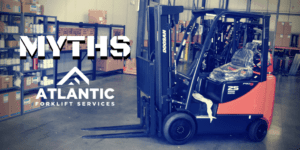Awhile back, we spent some time busting some widely-help forklift myths- things that people swear are true but just aren’t. Let’s take a few more minutes and put some other forklift myths to rest.
MYTH: OSHA requires forklift operators to carry a card certifying they are qualified to operate a forklift.
FACT: Nope. OSHA does require that a certified operator be issued some type of proof of qualification, but nowhere does it specify that the operator must carry that proof with them like a driver’s license.
MYTH: Most forklifts are sufficiently maintained.
FACT: We’d like to think that everyone who owns or operates a forklift is paying attention to regular maintenance requirements and taking the proper steps to make sure a truck is properly maintained and equipped, but we know better don’t we?
MYTH: Some pedestrians working around forklifts believe if they cannot see the forklift, they are safe.
FACT: Accidents happen between pedestrians and forklifts more often than necessary and a warehouse employee doesn’t need to be in direct contact with a forklift to be injured by one. A forklift could knock over shelving, or push another load of materials off a shelf while loading the other side of that shelf.
The fact is, accidents happen and being aware of everything around you can only work in your favor when things start to go south.
MYTH: Seatbelts are required on forklifts.
FACT: Seatbelts are not, in fact, specifically named in OSHA’s safety regulations as they pertain to forklifts.
However, employers are required to protect employees from hazards and as far as OSHA is concerned, that includes equipping forklifts with passive restraint systems (seatbelts, to you and me).
If there’s anything you thought you knew for sure about forklifts but think you may be mistaken, don’t hesitate to contact us. We’ve got the resources and the knowledge to take these myths down.

